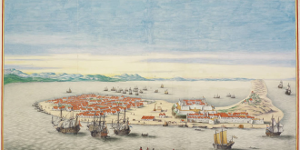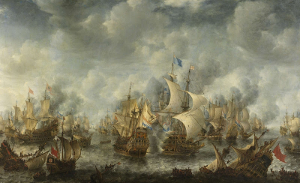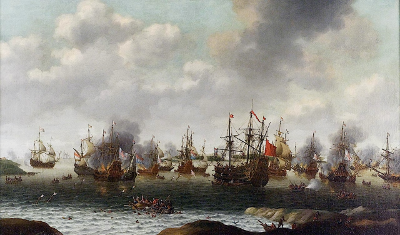The Anglo-Dutch Wars
The Anglo-Dutch Wars were a series of mainly naval conflicts between England and the Netherlands in the 17th and 18th Centuries. Both nations were striving for supremacy on the high seas and in their respective colonies. The First Anglo-Dutch War was from 1652 to 1654. The Netherlands had, in 1648, concluded a treaty with Spain, the Peace of Münster, that roughly coincided with the Peace of Westphalia, which ended the widespread Thirty Years' War, which devastated Europe. The Peace of Münster was significant as well because it meant the end of the Eighty Years' War, a long and fierce struggle by the Seven United Provinces of the Netherlands to break free from the Spanish yoke. 
Not coincidentally, the Netherlands by the mid-17th Century was a leading economic and seaborne power, on par with and perhaps even surpassing England, France, and Spain. The influence and power of Europe-leading Portugal had subsided by this time, and Dutch ships routinely took over Portuguese trade routes, lands, and possessions in the East Indies and elsewhere. Once peace with Spain was secure, the Netherlands continued to focus on its economic empire; and, because the wider conflict in Europe had subsided, Dutch leaders felt comfortable with decommissioning warships that they thought were no longer needed. England had been a friend to the Netherlands in the days of Queen Elizabeth I, who had supported a Dutch Revolt in 1581 and who had counted on Dutch support seven years later during the conflict with the Spanish Armada. Elizabeth's successor, King James I, signed a peace treaty with Spain in 1604. The next English monarch, Charles I, worried about competition with the Netherlands and, to that end, entered into a series of secret agreements with Spain, at the same time directing a sharp increase in the construction of English warships. Thus, by the mid-17th Century, England had more warships than the Netherlands did and Dutch cargo ships outnumbered English cargo ships. The ruler of England after Charles I, Oliver Cromwell, continued policies designed to counter Dutch influence on the high seas and in North America, where both countries had set up colonies. The European powers ratcheted up tensions in the 1650s, and a refusal of Dutch Lieutenant-Admiral Maarten Tromp to comply with an English request to salute the English fleet resulted in shots fired. The war began on July 10. The First Anglo-Dutch War 
Dutch good fortunes continued the following year at the Battle of Leghorn, and the Netherlands was soon in control of much of the Mediterranean area and the English Channel. The Netherlands had jump-started its warship construction program and had almost caught up to England. A few inconclusive skirmishes later, England had turned the tables and enacted a blockade of the Dutch coast. The final battle of the war turned out to be the Battle of Scheveningen, on Aug. 10, 1653. Dutch naval hero Tromp was killed in the battle, but England didn't enjoy a much stronger position as a result of the battle. By this time, both countries had run out of money to fund the war and resolve to keep it going. The 1654 Treaty of Westminster ended the war. A decade later, as both countries had pursued the same sort of colony-building and trade-building that had brought them into conflict earlier, war was again on the horizon. The Second Anglo-Dutch War began in 1665 and, most notably in North America, resulted in the seizure by the future English King James II of New Netherland, which was thriving economically but didn't have the military resources to defend itself when a cadre of English ships came calling. The Second Anglo-Dutch War The Third Anglo-Dutch War The war dragged on, and the French forces that had invaded overland were suffering from long supply lines. As well, England and France suffered from a distrust of each other's intentions. The Dutch fleet was victorious over a combined English-French fleet in 1673 in not one but two Battles of Schooneveld, with de Ruyter proving his mettle once again. The final naval battle of the war was the Battle of Texel, again a Dutch victory. Also in 1673, Dutch forces in North American had briefly retaken New York City, once the Dutch settlement of New Amsterdam. The mood for war in both England and France soured, and the three countries began peace negotiations. The February 1674 Treaty of Westminster ended the war. The Fourth Anglo-Dutch War Much had changed in the century since the last war. The Netherlands, in particular, was on the decline, even as the British star was on the rise. Dutch money and weapons helped to finance the American war effort, and it was the Dutch governor of St. Eustatius, Johannes de Graeff, who first saluted the flag of the United States, in 1776. The fledging United States established diplomatic relations with the Dutch Republic in 1782; this did not translate into a formal alliance, however. In the intervening years, Dutch ships and leaders engaged in actions that Britain thought increasingly hostile, and a declaration of war came in 1780. British ships commenced a blockade of the Dutch homeland that rendered that part of the conflict relatively tranquil. The one exception was the 1781 Battle of Dogger Bank, which was inconclusive. Britain also targeted Dutch ports and other colonial properties around the world. British troops took particular delight in capturing and then sacking the Dutch holdings on St. Eustatius, in 1781. The victors had similar successes elsewhere in the West Indies, although the Dutch held on to Suriname. The Dutch East India Company had declined along with the Dutch navy during the latter half of the 18th Century, and the former had to request help from the latter in order to defend its positions in Asian waters. As elsewhere, British forces were victorious for the most part. Britain gained at Holland's expense, militarily and economically. |
|



 Dutch forces fought back and scored the capture of the English flagship Prince Royal and then, in 1667, pressed home their advantage on English soil (or, at least, waterways), resulting in what many historians regard as the worst naval defeat in the country's long history. The Raid on the Medway was a surprise attack in which Dutch ships under the command of Admiral Michiel de Ruyter sailed up the Thames and not only set fire to a number of English ships but also captured two of England's finest vessels, including the flagship, the Royal Charles, and towed them away. England sued for peace, and the Netherlands agreed.
Dutch forces fought back and scored the capture of the English flagship Prince Royal and then, in 1667, pressed home their advantage on English soil (or, at least, waterways), resulting in what many historians regard as the worst naval defeat in the country's long history. The Raid on the Medway was a surprise attack in which Dutch ships under the command of Admiral Michiel de Ruyter sailed up the Thames and not only set fire to a number of English ships but also captured two of England's finest vessels, including the flagship, the Royal Charles, and towed them away. England sued for peace, and the Netherlands agreed.
